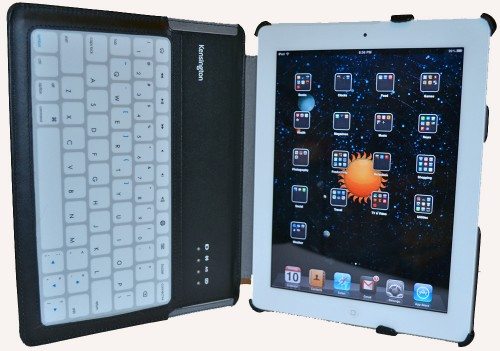 The one thing I dislike about using my iPad is the on-screen keyboard, and it seems many people agree with me – evidenced by the sheer number of Bluetooth keyboards and keyboard cases on the iPad accessories market. Typing a quick email on an iPad is fine, but typing anything longer is slow and error-filled. The on-screen keyboard is probably the major reason so many describe the iPad as a consumption device and not a creation device. When we updated to the iPad 2, we passed along our original iPads to some nieces and a nephew in college, and we gave them each a keyboard case so they could easily take notes in class and still be able to pay attention to the lecture. We’ll be passing on the iPad 2s to other nieces when we upgrade to the new iPad, so I’m looking for good keyboard cases for iPad 2. I was happy to be selected to review the KeyLite Ultra Slim Touch Keyboard Folio for iPad 2 from Kensington when they offered one to The Gadgeteer.
The one thing I dislike about using my iPad is the on-screen keyboard, and it seems many people agree with me – evidenced by the sheer number of Bluetooth keyboards and keyboard cases on the iPad accessories market. Typing a quick email on an iPad is fine, but typing anything longer is slow and error-filled. The on-screen keyboard is probably the major reason so many describe the iPad as a consumption device and not a creation device. When we updated to the iPad 2, we passed along our original iPads to some nieces and a nephew in college, and we gave them each a keyboard case so they could easily take notes in class and still be able to pay attention to the lecture. We’ll be passing on the iPad 2s to other nieces when we upgrade to the new iPad, so I’m looking for good keyboard cases for iPad 2. I was happy to be selected to review the KeyLite Ultra Slim Touch Keyboard Folio for iPad 2 from Kensington when they offered one to The Gadgeteer.
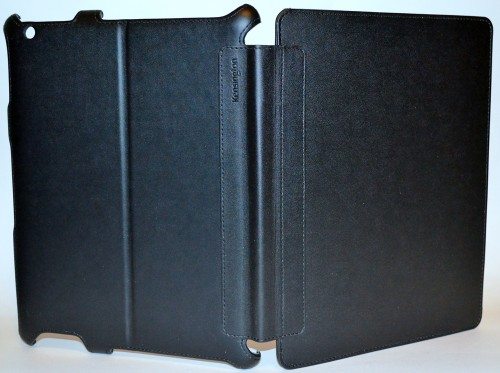 The KeyLite folio case is made of leather or faux leather – I can’t find anything that tells me which. It’s only available in black. The case is plain on the front, but the spine is embossed with the Kensington name. The stitching is done in black thread and is even and straight. The case measures about 7.75″ wide X 9.6″ tall X 0.75″ thick and weighs 12.95 ounces on my digital kitchen scale.
The KeyLite folio case is made of leather or faux leather – I can’t find anything that tells me which. It’s only available in black. The case is plain on the front, but the spine is embossed with the Kensington name. The stitching is done in black thread and is even and straight. The case measures about 7.75″ wide X 9.6″ tall X 0.75″ thick and weighs 12.95 ounces on my digital kitchen scale.
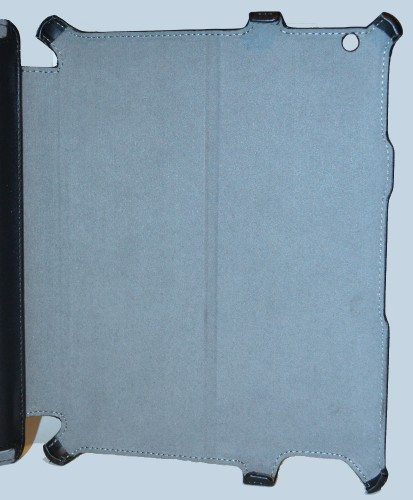 The iPad holder is reinforced with a stiffener, but there is a channel left between the two boards to serve as a hinge for the stand function. The interior is lined with gray microfiber material. There are four, hard, formed corners that snap up over the corners of the iPad to hold it in the case. There are two other holders that fold over onto the front of the iPad. I wasn’t sure what the purpose of these extra holders were at first, but they hold the iPad in the case when you are using the keyboard.
The iPad holder is reinforced with a stiffener, but there is a channel left between the two boards to serve as a hinge for the stand function. The interior is lined with gray microfiber material. There are four, hard, formed corners that snap up over the corners of the iPad to hold it in the case. There are two other holders that fold over onto the front of the iPad. I wasn’t sure what the purpose of these extra holders were at first, but they hold the iPad in the case when you are using the keyboard.
Three of the corner holders fit snugly and securely over the edges of my iPad. The one shown on the upper left was loose and would unexpectedly pop off the corner of the iPad. The other five holders seemed to hold the iPad 2 securely.
The KeyLite case comes with a USB charging cable and a user’s guide and warranty booklet. There’s no text in the user’s manual, only gray-scale drawings. It’s a bit hard to get information about the colored status lights from a gray-scale drawing.
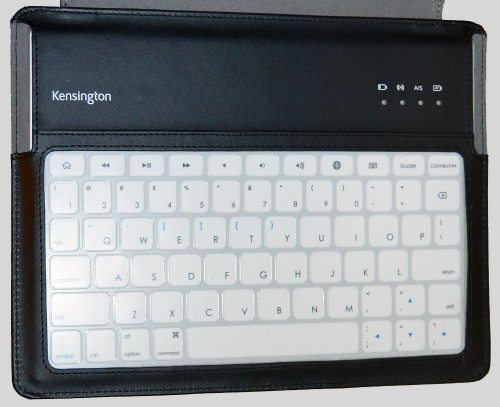 The keyboard is unlike any other I’ve seen in an iPad case. It’s almost completely flat and has a gray background, white “keys”, and a pearlescent finish. Kensington describes it as a touch-sensitive keyboard with liquid- and dust-proof keys. The keys aren’t separate, they are merely “suggested” by the white color, an almost flat ridge outline, and a label showing which key it is. The the home keys are marked with almost flat bars. Just like every other iPad keyboard case, the keyboard is not full-sized, and the QWERTY keyboard has non-standard placement of the punctuation keys. It has some iPad-specific keys, like home, media playback controls, volume adjustment, and a key to bring up the on-screen keyboard. There are status lights at the upper right of the keyboard.
The keyboard is unlike any other I’ve seen in an iPad case. It’s almost completely flat and has a gray background, white “keys”, and a pearlescent finish. Kensington describes it as a touch-sensitive keyboard with liquid- and dust-proof keys. The keys aren’t separate, they are merely “suggested” by the white color, an almost flat ridge outline, and a label showing which key it is. The the home keys are marked with almost flat bars. Just like every other iPad keyboard case, the keyboard is not full-sized, and the QWERTY keyboard has non-standard placement of the punctuation keys. It has some iPad-specific keys, like home, media playback controls, volume adjustment, and a key to bring up the on-screen keyboard. There are status lights at the upper right of the keyboard.
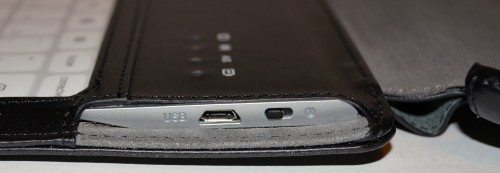 The keyboard has a built-in rechargeable battery, but I couldn’t find any specifications for the type. It’s charged with the included USB-to-microUSB cable. Kensington says you can expect 68 hours of working time and up to 45 days of standby time from a charge. I plugged the KeyLite case up to my Charge4All charging tube and left it charging for several hours.
The keyboard has a built-in rechargeable battery, but I couldn’t find any specifications for the type. It’s charged with the included USB-to-microUSB cable. Kensington says you can expect 68 hours of working time and up to 45 days of standby time from a charge. I plugged the KeyLite case up to my Charge4All charging tube and left it charging for several hours.
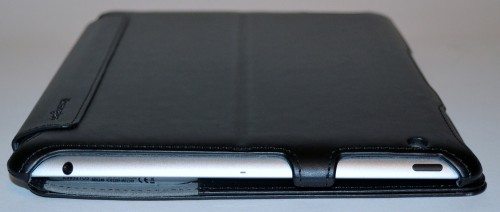

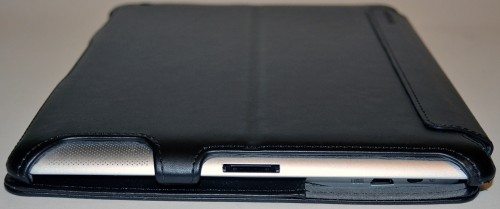 Other than the one loose corner I mentioned earlier, the iPad seemed to be held securely by the other five holders. All ports and buttons are left uncovered by the KeyLite folio. Quite a bit of the iPad’s metal back was also left uncovered. I was able to use all the buttons, and I could plug in headphones and the charging cable without problems.
Other than the one loose corner I mentioned earlier, the iPad seemed to be held securely by the other five holders. All ports and buttons are left uncovered by the KeyLite folio. Quite a bit of the iPad’s metal back was also left uncovered. I was able to use all the buttons, and I could plug in headphones and the charging cable without problems.
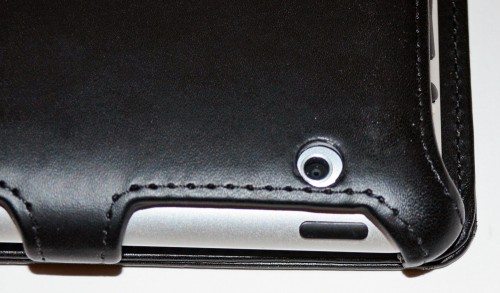 The camera opening in the back of the iPad holder didn’t interfere with taking pictures.
The camera opening in the back of the iPad holder didn’t interfere with taking pictures.
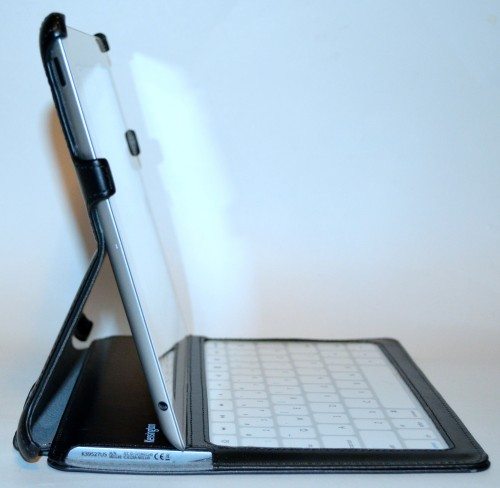 Information about the KeyLite folio case said that it was a two-position stand. Unless they mean you can stand it up in the vertical position, as shown in the top photo in this review, I’m not sure what the second position is. There’s really only one typing position you can achieve. You have to pop the iPad out of the two corner holders near the spine, bend it at the “hinge” in the back of the iPad holder, and bump the side of the iPad against the leather strip at the top of the keyboard to use the horizontal stand. You can’t really adjust the viewing angle. If you’re tall and have a low tabletop, you may find this viewing angle doesn’t work well for you. I had my 6’2″ husband try it, and he asked me how to adjust it for a better angle. You’ll notice the iPad obscures the status lights in the typing position, so you won’t be able to see the low-battery warning light.
Information about the KeyLite folio case said that it was a two-position stand. Unless they mean you can stand it up in the vertical position, as shown in the top photo in this review, I’m not sure what the second position is. There’s really only one typing position you can achieve. You have to pop the iPad out of the two corner holders near the spine, bend it at the “hinge” in the back of the iPad holder, and bump the side of the iPad against the leather strip at the top of the keyboard to use the horizontal stand. You can’t really adjust the viewing angle. If you’re tall and have a low tabletop, you may find this viewing angle doesn’t work well for you. I had my 6’2″ husband try it, and he asked me how to adjust it for a better angle. You’ll notice the iPad obscures the status lights in the typing position, so you won’t be able to see the low-battery warning light.
The Kensington Bluetooth keyboard connected without a glitch to my iPad 2, and it reconnected immediately, even after I had turned off Bluetooth on the iPad when I wasn’t using the keyboard.
The only reason to add the weight and bulk of a keyboard folio case – in my opinion, at least – is so you’ll have a “real” keyboard at hand when you need to type. The real keyboard should be better than the on-screen virtual keyboard. The keys should be “real”, and they should have some travel and some tactile feedback when you strike them. They don’t have to click, but you need to feel the individual keys and feel them move to be able to touch-type.
The keys on this KeyLite case offer none of these features. Typing on this keyboard doesn’t really feel any different than typing on the iPad’s on-screen keyboard. There are no physical keys, only the suggestion of keys. There is no travel or feedback of any kind when you type on them. Combine the lack of any physical feedback and the under-sized format of the keyboard with the fact that the keyboard completely missed somewhere between a quarter and a third of my keystrokes, and you get a keyboard that is impossible to type on.
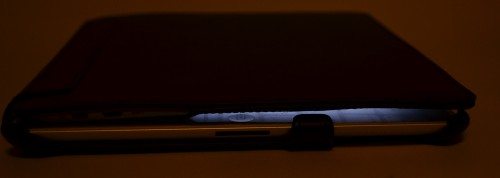 The KeyLite Folio also has magnets that are designed to utilize the iPad 2’s automatic sleep/wake functions. However, the front of the case didn’t line up well with the back when the case was closed, and this meant the magnets didn’t line up properly with the iPad’s sensor. The case didn’t close well, either. The front of the case was very stiff because of the keyboard on its backside, and the holders keeping the iPad in place kept the front lifted away from the face of the iPad, so the magnets in the front cover never seemed to get close enough to activate the sleep/wake sensor. I could line up the edges and then press the case together and the iPad would turn off – as evidenced by the “click” it makes when the Smart Cover puts my iPad to sleep. The second I let it go, the iPad came back on; I could tell because the screen came on. You can see in the picture here that my iPad is on even though the front cover is closed. Perhaps some sort of closure on the case would make the front line up properly and keep the front and back close enough to operate the sleep/wake functions, but there is no closure on this case. You’ll probably need to disable the automatic sleep/wake functions if you use this case.
The KeyLite Folio also has magnets that are designed to utilize the iPad 2’s automatic sleep/wake functions. However, the front of the case didn’t line up well with the back when the case was closed, and this meant the magnets didn’t line up properly with the iPad’s sensor. The case didn’t close well, either. The front of the case was very stiff because of the keyboard on its backside, and the holders keeping the iPad in place kept the front lifted away from the face of the iPad, so the magnets in the front cover never seemed to get close enough to activate the sleep/wake sensor. I could line up the edges and then press the case together and the iPad would turn off – as evidenced by the “click” it makes when the Smart Cover puts my iPad to sleep. The second I let it go, the iPad came back on; I could tell because the screen came on. You can see in the picture here that my iPad is on even though the front cover is closed. Perhaps some sort of closure on the case would make the front line up properly and keep the front and back close enough to operate the sleep/wake functions, but there is no closure on this case. You’ll probably need to disable the automatic sleep/wake functions if you use this case.
You can fold the front cover all the way to the back. It’s flat enough that you can hold the iPad one-handed. Unfortunately, I found that the automatic sleep/wake function did work with the front folded to the back. Having the front flush to the back put the front cover magnets close enough to activate the sensor on my iPad 2 and keep it asleep so long as the front was folded to the back.
I cannot recommend the Kensington KeyLite Ultra Slim Touch Keyboard Folio. This is a perfect example of how things can go wrong when the design emphasizes style over function. The Bluetooth keyboard is attractive, but the design ignored the functions a keyboard must have – at least if it’s going to have a chance of functioning better than the on-screen keyboard. The automatic sleep/wake features don’t work properly, so you’ll need to turn off that function when you use this case. Kensington has other keyboard cases that have real keyboards, many of them cheaper than the KeyLight Touch keyboard. You should look at them if you are in the market for a keyboard folio from Kensington.
ESR for MagSafe Wallet with Stand, RFID Blocking with MagSafe Ring, 5 Card Holder for Phone Case, Slim Leather Magnetic Wallet for iPhone 17/16/15/14/13/12 Series(Not for Mini), Selected Samsung,Black
43% Offfor MagSafe Wallet, Stronger Magnetic Wallet for iPhone 17/16/15/14/13/12 Series, 7 Cards Holder, Magnetic Phone Wallets, Vegan Leather Minimalist Slim RFID for iPhone Wallets, 1 Slot, Black & Black
$19.98 (as of December 20, 2025 12:04 GMT -05:00 - More infoProduct prices and availability are accurate as of the date/time indicated and are subject to change. Any price and availability information displayed on [relevant Amazon Site(s), as applicable] at the time of purchase will apply to the purchase of this product.)Product Information
| Price: | $119.99 |
| Manufacturer: | Kensington |
| Pros: |
|
| Cons: |
|



Gadgeteer Comment Policy - Please read before commenting
I have a ZAGG Bluetooth keyboard for my iPad 2, but now that my iPad 3 will arrive on Friday 🙂 and the 2 w/keyboard will be donated to others, I’m looking for a better keyboard. The Kensington doesn’t seem to be the one. Looking forward to the next review for the *Best* iPad 3 keyboard. Thanks,
@1000Acres Sometimes I wonder if just the Smart Cover and stand-alone Bluetooth keyboard is really all you need.
We have pretty much tried them all and the main problem with all iPad-size keyboards is they are too small to be use comfortably.
We have stop considering any keyboard that is the same width as the iPad.
The only functionally valid solution for extended typing with the iPad is a full-size keyboard. Everything else is no better than the on-screen one.
I think I would go with the Apple wireless keyboard and a case of some sort (I’ve not searched for one) that can combine the two. I use this keyboard with my iMac, so I’m super comfortable with it. Battery life is outstanding too.
@Julie Butch has an Incase Travel Kit Plus that I reviewed after the original iPad that has room for the iPad 2 in the Smart Cover and the HyperShield back cover. There’s also a pocket designed for the Apple Bluetooth keyboard and room for his Charge4All charging tube and other things. It even fits in his Tom Bihn Empire Builder with his laptop. I sound like a catalog of Gadgeteer reviews, don’t I? 😉 Here’s the Incase review:http://the-gadgeteer.com/2010/10/26/incase-travel-kit-plus-for-ipad-review/
@Janet that’s not exactly what I had in mind… I’d thinking more of some type of case that would allow the iPad and the Apple Wireless case to be combined into one device sorta… if that makes sense… Maybe I should design something and put it on Kickstarter! 😉 Hmmm… maybe I should.
@Julie I thought that was actually what you meant, but a case like that would add some serious bulk to the iPad!
@Julie Also not exactly what you’re looking for, but Smythe reviewed the Incase Origami cover for the Apple keyboard that opens up into a stand for the iPad. http://the-gadgeteer.com/2011/08/13/incase-origami-workstation-review/
@Julie…
If you want to carry both the Apple Bluetooth keyboard and the iPad, check out the M-Edge Folio:
http://www.rainydaymagazine.com/RDM2010/Home/August/Week4/RDMHomeAug2610.htm#iPadCoversBOB_Folios
Click on any of the images for a larger version.
The side has a pocket which will hold the Apple keyboard. It is a bit thicker, but it will fit all the iPads as it uses the corner bands instead of a molded case.
@RainyDayInterns I’m not really looking for a case to carry both items in. I’m looking for something to join the two together to make a laptop like configuration. The only time I’d probably want to use it is when I go for my every 3 week treatments at the hospital and need to find something to do for an hour. I could use that configuration to answer emails while sitting in a chair.
Great review Janet. I’ve been looking for a folio-keyboard case for my iPad as well. Best one I’ve read about is the Belkin folio with keyboard, it’s got a pretty neat folding mechanism. About $100. Either that or I’ll get the Apple wireless keyboard. There’s this thing called WINGStand, check it out, it’s like a little stand and props your iPad/iPhone with the Apple Keyboard.
@Phoebe Thanks! It’s funny you mention the WINGStand, because Julie and I were talking about them yesterday when we were talking about this subject. The price is right for the WINGStand; have you tried them?
@Julie…Ah. Then your KickStarter route may be the one to follow 🙂 Maybe a clip which will connect to both the ipad and the keyboard?
Also…the clip can function as the hinge and carry handle.
@RainyDayInterns excellent idea for a carry handle. Maybe we should team up and do it together? 🙂
@Janet No I haven’t tried that yet! But if I decide to get the Apple wireless keyboard, I’ll get that the WINGStand for sure. It’s small and seems very handy. Let me know if you do try it!
@Phoebe The one thing that concerns me about the WINGStand is that all their videos show it sitting on a table or some other flat surface, so I’m not sure they’d work on a lap. As for the Apple Bluetooth keyboard, it works great with the iPad. It pairs right up, and it’s full-sized and easy to type on. I like that the battery compartment gives it a little incline, too. The Apple keyboard and the WINGStand together are cheaper than most keyboard cases, too.